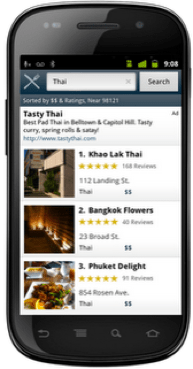As more and more consumers user their smartphones for search, Google’s mobile search and display ads are growing like crazy. As we reported a few weeks ago, Google’s mobile ad revenues are expected to more than double from an estimated $2.5 billion last year to $5.8 billion in 2012. And today, Google is revealing a number of new data on the growth of mobile search ads and formats.
Google’s lead product manager for mobile search ads, Surojit Chatterjee, tells us that in December 2011 mobile search ad request volume was more than twice as high as it was in December 2010. Mobile search in general has grown five-fold worldwide in just the past two years, which is a rate comparable to the early days of desktop Google Search, he adds.
Chatterjee says that quality of search ads is increasing thanks to some of the new factors being considered in mobile search ad rankings. For example, mobile web-optimized sites are now ranked higher. Since August 2011, Google has seen more than a 50 percent increase in the number of AdWords advertisers with a mobile optimized sites.
And proximity is also a factor in mobile search ads ranking. Basically, the distance between a user and an advertiser’s business location affects how an ad performs in AdWords on mobile devices.
As he explains, the company is looking to give advertisers better ways to connect with users on mobile search, and serve more relevant ads. Besides search, another mobile ad format that has been performing well for advertisers on mobile search is click-to-call, which allows users to click on phone number to call and connect with advertisers directly. Chatterjee says that more than half a million active advertisers are using click-to-call as a format in mobile advertising. And Google is seeing over 10 million calls per month on average from click-to-call ads on search and Google Display Network.
As for the future, Chatterjee explains that Google will be using mobile signals even more to serve more relevant ads. It’s also about understanding the mobile user better, and creating formats and user experiences that speak to the consumer when building ad relevance and ranking models. There will also be more innovation coming out of tablet ad formats, he adds.
